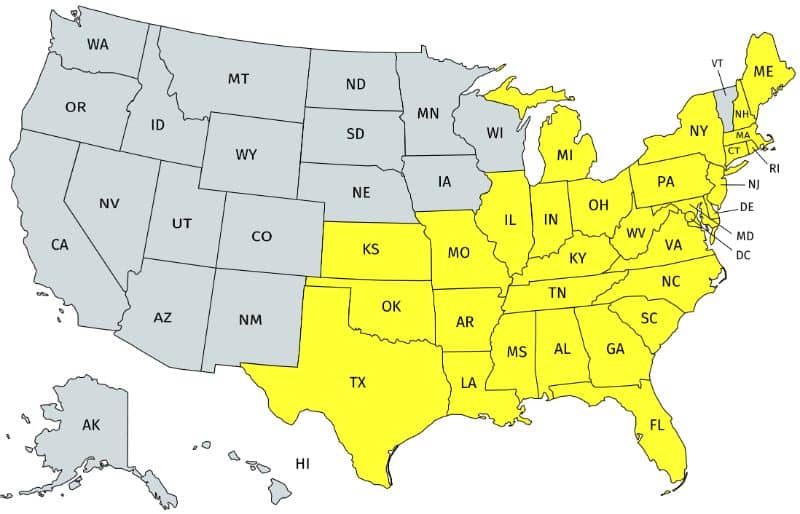The Eastern Box turtle, also known as the Common Eastern box turtle is a sub-species of North American box turtles of the genus Terrapene native to the Eastern part of the United States. Like all other box turtles, the Eastern box turtle has the ability to fully retract its limbs inside its shell and close it with a hinge on the bottom of its shell. Hence the name box turtle. This mechanism protects the box turtle from predators.
The Eastern has a brownish or black shell that is decorated with a yellowish to orange radiating pattern of lines and dots. The colouration and pattern serve as a camouflage for the box turtle to help them in hiding under bushes or in grass.

The skin tones of Eastern box turtles varies. The most common are black, adorned with yellow and red stripes and markings. Eastern box turtles have a sharp and horned beak. The front foot of five toes whereas hind foot has four.
This post provides an overview of the most important Eastern box turtle care tips and facts. Here is a quick overview of the main contents:
– Eastern box turtle care tips
– Eastern box turtle habitat and range
– Size
– Lifespan
– How to tell the gender of an Eastern box turtle?
– Scientific classification
Eastern box turtle care tips
Eastern box turtles are very beautiful and loving creatures and you are lucky if you have one as a pet. However, keeping box turtles as pets requires a lot of effort and enthusiasm from the keeper. They need the right diet, light, temperature, humidity and habitat in order to stay healthy and active. Unfortunately, too many box turtles are kept at suboptimal conditions that will lead to health issues and a reduced lifespan.
However, if you are willing to provide the right housing, diet and lights for an Eastern box turtle, they are lively and fun pets to have around. The following chapters will teach you the most important Eastern box turtle care tips.
Eastern box turtle diet
Like all other species of box turtles, Eastern box turtles are omnivores. That means that they will and can be fed a variety of items. Half of their diet should consist of live low-fat protein sources like worms, slugs, crickets, etc. The other half should consist of vegetables, fruits, and leafy greens. As additional supplements, you can feed them cooked lean meats, canned premium box turtle food or premium low-fat dog food.
The diet of the Eastern box turtle should consist of the following:
- 50% Proteins: Earthworms, Slugs, Snails, Mealworms, Crickets, Grasshoppers etc.
- 30% Vegetables: Peas, Sweet Potatoes, etc.
- 10% leafy greens: mustard greens, collard greens, etc.
- 10% Fruits: Bananas, Kiwis, Apples, etc
This post provides a complete overview of the box turtle diet.
Eastern box turtle habitat and range
As mentioned earlier, the Eastern box turtle is native to the eastern parts of the United States. They can be found in most US states from Maine to Florida and from Michigan to Texas. North and South Carolina still have the highest wild populations.

Wild Eastern box turtles live in forests with a humid floor. In nature, they like to hide under logs and stones where a high level of humidity occurs. During daytime, they often move to open fields and grasslands to soak up the sun to regulate their body temperature. Like all box turtles, they are ectothermic creatures which means their body can’t regulate temperatures automatically like ours. They depend on outside temperatures to regulate their body temperature. During hot temperatures, they often bury into the soil to keep their body temperature low. Eastern box turtles can often be found soaking in shallow waters.
While it is always best to keep your box turtle in an outdoor habitat in a state where they naturally occur, they can also thrive indoors if kept at the right temperatures and humidity levels. Regardless of location, a habitat for an Eastern box turtle should have the following features:
- You should make sure that both a warmer and cooler are available for them so that they can move from one area to another whenever they feel so. If kept outside, this can be a sunny and a shady side. If kept indoors, the heating lamp should be sitting on one side of the pen so the heat distributes unevenly and the turtle can move to the required temperatures.
- At night time, the temperatures should not fall below 65°F (18°C).
- Make sure that a shallow pan of water is available to them at all times of the day.
Read how to create the perfect habitat for your box turtle here.
Ideal temperatures and humidity levels
Eastern box turtles require ideal temperature and humidity levels. They should get enough sunlight and the right temperatures every day. If the temperatures are too low, the turtle may go into hibernation mode and stop eating altogether. Too low humidity levels may lead to eye diseases and other medial issues.
The ideal temperatures for Eastern box turtles throughout the day are:
- A warm area with sunlight and a temperature between 85-88°F (29-31°C). Outdoors, this can be a sunny area in the enclosure and indoors the temperatures can be achieved with a heating lamp and sunlight can be substituted with a UVA and UVB lamp.
- A cooler place with temperatures between 70 to 75°F (21-24°C).
- A moist place for the turtle to burry into with a temperature of 70 to 72°F (21-22°F).
- The ideal temperature at the night time is 65 to 70°F (18-21°F).
- In winters, they mostly hibernate for around 4 months by digging themselves into the soil.
The ideal humidity level for Eastern box turtles is around 60%. For hatchlings, it should be even higher. You can achieve the right humidity level by using a moisture holding substrate and misting it twice a day.
More on temperatures, light, UV requirements and humidity levels for box turtles can be found here.
Size
An adult Eastern Box turtle is 4.5 to 6 inches (11-15cm) long. However, there are some specimens reaching more than 7 inches. The largest ever recorded Eastern box turtle reached a size of 7.8 inches (20cm). An adult Eastern box turtle typically weighs between 1-2 pounds.
Hatchlings are around the size of a quarter dollar coin and weigh less than 10 grams.

Lifespan
Most Eastern box turtle hatchlings in the wild will not reach the age of 2 years. After laying the eggs, the hatchlings are left alone to survive from the day they are born. Since the shell of baby box turtles is soft and they do not have the ability to retract into their shell, most of them become prey of birds, wild animals or even other adult turtles who feed on them.
Those Eastern box turtles who manage to survive their infancy can be very long-lived. Some live for up to 100 years. The average lifespan of an Eastern box turtle is 30-40 years. Many box turtles in captivity are not able to survive that long because of unsuitable living conditions and an improper diet.
How to identify the gender of an Eastern box turtle
Unlike other animals, it is impossible to identify the gender of box turtles just by looking at their genitals. However, there are other indicators that can be used to tell the gender of an Eastern box turtle.
Usually, males have thicker and longer tails than females. The plastron is flat in females and whereas concave in males. The carapace is a bit flattened in males and more domed in females. Males’ irises are of red colour and brown in females. The foreleg markings of males are colourful and have short and curved claws of the hindfoot.
Here is an overview of gender indicators for Eastern box turtles:
| Male Eastern Box Turtles | Female Eastern Box Turtles |
| Thicker and longer tails | Shorter tails |
| Concave plastron | Flat plastron |
| Red colored iris | Brown colored iris |
| Colourful foreleg markings | Less colourful markings |
Scientific classification
- Kingdom: Animalia
- Phylum: Chordata
- Class: Reptilia
- Order: Testudines
- Suborder: Cryptodira
- Superfamily: Testudinoidea
- Family: Emydidae
- Genus: Terrapene
- Species: Terrapene carolina
- Subspecies: Terrapene carolina carolina
Terrapene carolina carolina is a subspecies of the Common box turtle. Other subspecies of Terrapene carolina are the Three-toed box turtle, the Florida box turtle, the Gulf Coast box turtle, the Mexican box turtle, the Yucatán box turtle as well ass the extinct subspecies Terrapene carolina putnami.

